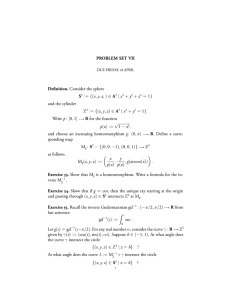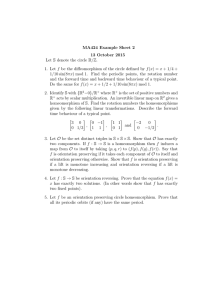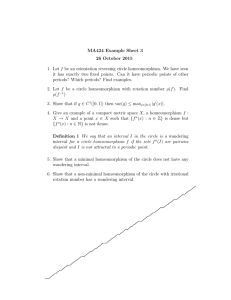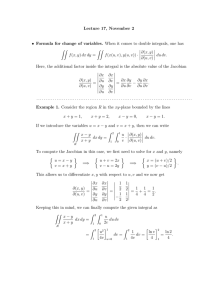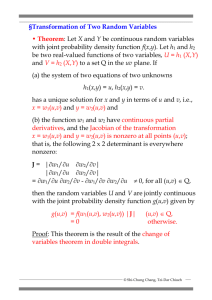1. Introduction Dmitri Burago Bruce Kleiner April 12, 2001
advertisement
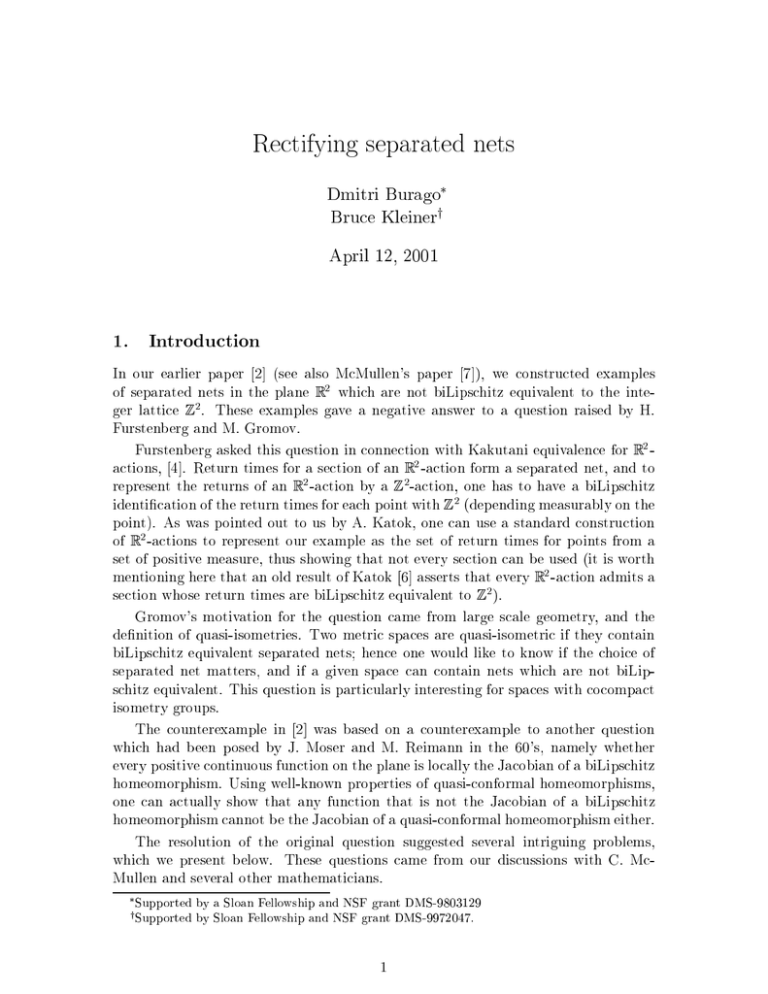
Rectifying separated nets
Dmitri Burago
Bruce Kleinery
April 12, 2001
1. Introduction
In our earlier paper [2] (see also McMullen's paper [7]), we constructed examples
of separated nets in the plane R 2 which are not biLipschitz equivalent to the integer lattice Z2. These examples gave a negative answer to a question raised by H.
Furstenberg and M. Gromov.
Furstenberg asked this question in connection with Kakutani equivalence for R 2 actions, [4]. Return times for a section of an R 2 -action form a separated net, and to
represent the returns of an R 2 -action by a Z2-action, one has to have a biLipschitz
identication of the return times for each point with Z2 (depending measurably on the
point). As was pointed out to us by A. Katok, one can use a standard construction
of R 2 -actions to represent our example as the set of return times for points from a
set of positive measure, thus showing that not every section can be used (it is worth
mentioning here that an old result of Katok [6] asserts that every R 2 -action admits a
section whose return times are biLipschitz equivalent to Z2).
Gromov's motivation for the question came from large scale geometry, and the
denition of quasi-isometries. Two metric spaces are quasi-isometric if they contain
biLipschitz equivalent separated nets; hence one would like to know if the choice of
separated net matters, and if a given space can contain nets which are not biLipschitz equivalent. This question is particularly interesting for spaces with cocompact
isometry groups.
The counterexample in [2] was based on a counterexample to another question
which had been posed by J. Moser and M. Reimann in the 60's, namely whether
every positive continuous function on the plane is locally the Jacobian of a biLipschitz
homeomorphism. Using well-known properties of quasi-conformal homeomorphisms,
one can actually show that any function that is not the Jacobian of a biLipschitz
homeomorphism cannot be the Jacobian of a quasi-conformal homeomorphism either.
The resolution of the original question suggested several intriguing problems,
which we present below. These questions came from our discussions with C. McMullen and several other mathematicians.
y
Supported by a Sloan Fellowship and NSF grant DMS-9803129
Supported by Sloan Fellowship and NSF grant DMS-9972047.
1
1. If two nitely generated groups are quasi-isometric, are they biLipschitz equivalent, (see [5, p. 23])? Here the groups are assumed to be equipped with word
metrics. Several special cases of this question are striking. Can G Z2 ever fail to
be biLipschitz to G? More generally: is every nite index subgroup of G biLipschitz
to G? By [12, 11] (see also [8, 1]) it is known that the answers are always armative
when the group is nonamenable.
2. If G1 and G2 are uniform lattices in the same connected Lie group, must
they be biLipschitz equivalent? (Logically speaking, this is a subcase of Problem
1.) Again this is known in the nonamenable case, i.e. the case of nonsolvable Lie
groups. Lattices with the same covolume are biLipschitz equivalent by an argument
using Hall's Marriage Lemma (see Lemma 4.1). A similar argument shows that
the the problem has an armative solution when the Lie group admits biLipschitz
homeomorphisms with constant Jacobian t for every t > 0. For instance, graded
nilpotent Lie groups and the isometry group of 3-dimensional Solv geometry admit
biLipschitz automorphisms which scale volume by an arbitrary factor.
3. If one forms a separated net in the plane by placing a point in the center of
each tile of a Penrose tiling, is the resulting net biLipschitz equivalent to Z2? More
generally, one can consider nets constructed as follows. Let P R n be a 2-plane
with irrational slope, and let B R n be a bounded subset with nonempty interior.
Take the set of points z 2 Zn for which the intersection (z + B ) \ P is nonempty, and
project it orthogonally to P . When B has small diameter this example can also be
described dynamically as the set of return times for a linear R 2 -action on an n-torus
to a section.
4. How can one characterize Jacobians of biLipschitz homeomorphisms R 2 ! R 2 ?
Several authors have studied the prescribed Jacobian problem in other regularity
classes [9, 3, 10, 13]. This question is already nontrivial if one restricts one's attention
to nonconstant functions which are locally constant on the complement of a simple
closed curve; for instance it seems plausible that in the case of a closed snowake
curve such a function is never the Jacobian of a biLipschitz homeomorphism. On the
other hand it seems likely that a function that assumes one value on the subgraph
of a continuous function R ! R and another value elsewhere is always the Jacobian
of a biLipschitz homeomorphism. One can reduce the n = 3 case of Problem 3 to a
situation similar to this.
In the remainder of this paper, we settle the n = 3 case of Problem 3 for planes
with Diophantine slope. More precisely, let 2 R satisfy the Diophantine condition
j pq j > qCd
(1.1)
for some C > 0; d > 2 and all p; q 2 Z; recall that the set of such has full measure,
and contains all algebraic irrationals. Now take P R 3 to be the graph of the linear
function x + y. Let X P be the separated net obtained by projecting the set
fz 2 Z3 : (z + B ) \ P 6= ;g orthogonally to P .
Theorem 1.2. X is biLipschitz homeomorphic to Z2.
We prove Theorem 1.2 via a general criterion which shows that a separated net is
2
biLipschitz to Z2 provided its density in large subsets approaches a limiting value
rapidly enough:
Theorem 1.3. Suppose Y R2 is a separated net. For > 0 and each measurable
subset U R 2 , dene e (U ) to be the density deviation
max #(UjU\jY ) ; #(UjU\j Y ) :
(1.4)
Then dene E : N ! R by letting E (k) be the supremum of the quantities e (U ),
where U ranges over all squares of theQform [i; i + k] [j; j + k] for i; j 2 Z. If there
exists a > 0 such that the product m E (2m ) converges, then Y is biLipschitz to
Z2 .
Remark 1.5. The technique from [2] can be used to produce separated nets which have
uniform asymptotic density (i.e. limk!1 E (k) = 1), but which are not biLipschitz to
Z2 .
In outline, the proof of Theorem 1.3 goes as follows. First we associate a Voronoi
type tiling with the net, and then introduce a function u whose value on each tile is
the reciprocal of the area of the tile. We then use Hall's Marriage Lemma to show
that the net is biLipschitz to Z2 if the function u is the Jacobian of a biLipschitz
homeomorphism R 2 ! R 2 . To construct such a homeomorphism, we let Si be the
image under scaling by 2i of the usual tiling of R 2 by unit squares, and then we
let ui : R 2 ! R be a function whose value of each square of Si is equal to the
average of u over that square. We dene a sequence of biLipschitz homeomorphisms
to a
i : R 2 ! R 2 such that Jac(i) = uui , and we show that i subconverges
Q
biLipschitz homeomorphism by showing the the innite product i biLip(i i 11)
u , and we get the desired
converges. The biLipschitz homeomorphism has Jacobian
p
homeomorphism by composing with the scaling x 7! x.
The paper is organized as follows. In section 2 we show in Corollary 2.2 that
nets in Theorem 1.2 satisfy the hypotheses of Theorem 1.3. In section 3 we give a
sucient condition for a function u : R 2 ! R to be the Jacobian of a biLipschitz
homeomorphism R 2 ! R 2 . In section 4 we use the main result from section 3 to
prove Theorem 1.3.
Acknowledgements. We would like to thank the anonymous referee for correcting many inaccuracies in the original version of the paper. We are grateful to
C. McMullen and G. Margulis for stimulating discussions.
2. Density estimates for the net X
Our objective in this section is to estimate the deviation of the density of X in squares
from the asymptotic density of X in R 2 .
Note that X is biLipschitz to its vertical projection X to the xy-plane. It is easy
to see that in the 3 dimensional situation it is enough to consider the case when B is
a ball; indeed, the set of points that we project to P to obtain X is the intersection of
Z3 with a slab W parallel to P . We will assume that the radius of B is small enough
3
that W does not contain a vertical interval of length 1. The general case can be
reduced to this one by splitting the slab W into a union of thin slabs, and observing
that our density estimates are additive1.
Observe that Z := W \ Z3 can be represented as the set of points (x; y; z) 2 Z3
satisfying jz x yj < for an appropriate . Since W does not contain vertical
intervals of length 1, it follows that < 21 , Z projects to the xy-plane injectively,
and hence X is biLipschitz homeomorphic to the vertical projection of Z to the xyplane, by a bijection which displaces points by a distance at most 21 . We denote the
projection of Z to the xy-plane by Z. Since there is a bounded displacement bijection
between Z and X , the reader may verify that it suces to obtain density estimates for
Z; the discrepancy between the densities in large squares is due to boundary eects
which do not aect the convergence of the product in the statement of Theorem 1.3.
Pick constants r; < 1=2. Set
S := fi 2 Z j d(r + i; Z) < g:
Proposition 2.1. There are constants C0 and c > 0 such that for any j and k,
j k1 #(S \ [j; j + k)) 2j Ckc0
Let = 2, and for any measurable U R 2 , let e(U ) be as in the statement of
Theorem 1.3, with Y = Z.
Corollary 2.2. For all j1; j2 2 Z, k 2 N , if U is a square of the form [j1 ; j1 + k] [j2 ; j2 + k], then je(U ) 1j Ckc1 for some constant C1 . It follows that the product
Q
i
i E (2 ) converges, where E is dened as in the Theorem 1.3.
The corollary can be deduced from the proposition by breaking the square U into
rows.
The remainder of this section is devoted to the proof of Proposition 2.1.
Let pqnn denote the convergents of the irrational number .
Lemma 2.3. For any n; k, j#(S \ [k; k + qn 1]) 2qnj 3.
Proof. This is an easy quantative renement of a standard argument showing that
the sequence fi mod 1g is equidistributed in the circle S = R =Z. We will assume
that pqnn > 0, the other case is absolutely analogous. Consider a nite sequence
xi = (i + k 1) mod 1 2 S, i = 1; 2; : : : qn. Then #(S \ [k; k + qn 1]) is nothing
but the number of xi's that belong to the interval of length 2 centered at r mod 1
in S.
Consider another sequence yi = (k 1) + i pqnn mod 1, i = 1; 2; : : : qn. Note that
0 < xi yi < qn( pqnn ) (where the rst inequality means that yn preceeds xn with
respect to the natural orientation of S.) This means that there are no other xj on
the segment between yi and xi . Indeed, otherwise j(i j ) mj < qn pn for some
integer m, and this contradicts to the fact that pqnn is the best approximation for by
Finicky readers may note that the discrepancy between the density estimate for closed slabs and
for open slabs is negligible.
1
4
rationals with denominators not exceeding qn. Hence the points xi and yi alternate
in S. This means that there is exactly one member of the sequence fxig between any
two neighboring (with respect to their positions in S, as opposed to their indices)
points yi0 and yi00 .
It is clear that the qn points y1; y2; : : : yqn are equispaced in S, and hence the
number of these points in any interval of length 2 diers from 2qn by no more than
1. Since xi's and yi's alternate, the number of xi 's in any interval diers from the
number of yi's in the same interval by no more than two. This completes the proof
of the lemma.
We now return to the proof of Proposition 2.1. Recall that
j pqk j < q q1
(2.4)
k
k k+1
for all k 0. Combining this with (1.1), we get
qk+1 < Cqkd 1 = Cqkh
(2.5)
where h := d 1 > 1.
If l 2 Z and qn l < qn+1, then from (2.5) we get qn > ( Cl ) h1 ; if moreover qnjl, we
may divide any interval of the form [j; j + l) into qln < C h1 l1 h1 intervals of length qn,
and apply Lemma 2.3 to each of these, getting
j#(S \ [j; j + l)) 2lj < C1h l1 h = C2lh
1
1
(2.6)
1
where C2 = C1h , h1 = 1 h1 2 (0; 1). Given any interval [j; j + k), let qn be the largest
denominator k, and set a := [ qkn ]. Then aqn > k2 , and we may apply (2.6) to get
1
j#(S \ [j; j + aqn )) 2(aqn)j < C2 (aqn)h < C2kh :
1
1
Repeating this estimate inductively to the leftover interval [j + aqn; k), we get that
j#(S \ [j; j + k)) 2kj < C2(kh1 + ( k2 )h1 + : : : ) = C3kh1
where
C3 := C2 1 :
1 2h1
3. A sucient condition for a function to be a Jacobian
The main result of this section is:
Proposition 3.1. Let u : R 2 ! R be a positive function which is constant on each
open unit square with vertices in Z2, and let > 0 be given. For any square S in R 2 ,
let e(S ) be the quantity
5
(
)
R
1
u
j
S
max 1 R ; j S
jS j S u
where jS j denotes the area of the square S . Dene an \error" function E : N ! R by
letting E (k) be the supremum of e() over the collection of k k squares of the form
[i; i + k] [j; j + k], where i; j 2 Z. If the product
Y
i
E (2i)
converges, then there is a biLipschitz homeomorphism : R 2 ! R 2 with Jac() = u
a.e.
The proof of Proposition 3.1 is based on the following:
Proposition 3.2. There is a constant C1 with the following property. Let T :=
[0; 2] [0; 2] R 2 , and let u : T ! (0; 1) be a function which is constant in each
square (i; i + 1) (j; j + 1), i; j = 0; 1. Then there is a biLipschitz homeomorphism
R
: T ! T which xes @T pointwise, so that Jac() = u a.e., where 1 = jT1 j T u,
u C1 .
and BiLip() max
min u
To prove Proposition 3.2, we will need two lemmas.
Let k k1 denote the l1 norm on R 2 , so k(x; y)k1 := max(jxj; jyj). Let Sr denote
the square fx 2 R 2 j kxk1 rg.
Lemma 3.3. Suppose uR1 : Sr !R R and u2 : Sr ! R are a continuous positive
functions of k k1, and Sr u1 = Sr u2. Then there is a biLipschitz homeomorphism
: Sr ! Sr which xes @Sr pointwise, so that Jac() = uu21 a.e., and
u1
biLip() max
min u1
where C2 is independent of u and r.
C2 Proof. We rst treat the case where u2 1 and
Dene f : [0; r] ! [0; r] by
Z
max u2
min u2
R
Sr u1
C2
=
R
Sr u2
= jSr j. Set u := u1.
1
2
f (t) := 21
u ;
St
so f (0) = 0 and f (r) = r. Now dene : Sr ! Sr by
(x) = f (kxk1) kxxk
1
when kxk1 6= 0, and (0) = 0. The map is dierentiable on Sr nf(x; y) j jxj = jyjg,
and calculation shows that
kDk(x) k1 max f (kkxxkk1) ; f 0(kxk1)
1
6
and
k[D(x)]
1 k k max
1
kxk1 ; 1 f (kxk1) f 0(kxk1)
u
where k1 is independent of u. These quantities are bounded by k2 max
min u where k2 is
independent of u. Hence
When
max u
min u
u:
biLip() k2 max
min u
(3.4)
is close to 1, then one gets that
which implies that
u 1 ;
k(D I )k k3 max
min u
k[D]1k max u k4
min u ;
where k3 and k4 are independent of u. Combining this with (3.4) we get that
max u C2
biLip() min u
(3.5)
when C2 is suciently large.
In the general case, we set
ui := uR ijSur j ;
Sr i
R
so Sr ui = jSr j. Applying the special case above, we obtain biLipschitz homeomorphisms 1 : Sr ! Sr and 2 : Sr ! Sr with Jac( i ) = ui a.e., whose biLipschitz
constants satisfy (3.5) (with u replaced by ui). Then := 2 1 1 : Sr ! Sr has
Jacobian uu21 a.e. and
u1
biLip() max
min u1
C2 max u2
min u2
C2
Lemma 3.6. We use the notation A(r1 ; r2) for the annulus B (0; r2) B (0; r1 ). Pick
0 < a < b, and set A := A(a; b). If u1 : A ! R and u2 : A ! R are positive Lipschitz
functions with
Z
A
u1 =
Z
A
u2 = jAj;
then there is a biLipschitz homeomorphism : A ! A with
and
Jac() = u u1 a:e:;
2
7
C3 u1 (1 + Lip(u ))
biLip() max
1
min u1
C3
max u2 (1 + Lip(u ))
2
min u2
(3.7)
for C3 = C3 ( ab ); moreover, when u1j@A = u2j@A , then can be chosen to x @A
pointwise.
Proof. We rst assume that u2 1, and set u := u1 . Using polar coordinates, we
dene I : [a; b] [0; 2] ! R by
I (r; ) :=
Z 0
u(r; )d:
Then dene 1 : A ! A to be the polar coordinate shear
(r; ) :
1 (r; ) := r; 2II
(r; 2)
The map 1 clearly denes a biLipschitz homeomorphism of A and
(r; )
Jac(1 )(r; ) = 2Iu
(r; 2)
for a.e. (r; ). Now dene f : [a; b] ! [a; b] by the relation
Z
A(a;t)
u(r; ) = Area(A(a; f (t)));
and 2 : A ! A by 2(r; ) = (f (r); ). Then 2 satises Jac(2)(r; ) =
a.e. (r; ). So we can set = 2 1, and for a.e. (r; ),
I (r;2)
2
for
Jac()(r; ) = [Jac(2)(1(r; )] [Jac(1)(r; )]
= I (r; 2) 2u(r; ) = u(r; ):
2
I (r; 2)
We now estimate biLip().
u ; (1 + Lip(u))) where k is independent of u.
One gets biLip(1 ) k1 max( max
1
min
u
u 1, then at points of dierentiability one has
When max
min u
max u
k (D1 I ) k k2 min u 1 + Lip(u)
which gives
u (1 + Lip(u))k3 ;
k[D1]1k max
min u
where k2 and k3 are independent of u. It follows that
max u
k4
biLip(1 ) min u (1 + Lip(u))
8
where k4 is independent of u. One easily gets that
u;
biLip(2 ) < k5 max
min u
where k5 is independent of u, and when
which implies
max u
min u
(3.8)
1 then
u 1 ;
k(D2 I )k k6 max
min u
u k
k[D2]1k max
min u
7
(3.9)
in this case. Combining (3.8) with (3.9) we get
u k8
biLip(2 ) max
min u
where k8 is independent of u. Therefore
max u
(3.10)
k 4 k 8
biLip() biLip(1 )biLip(2 ) min u (1 + Lip(u))
:
(3.11)
We now return to the general case when u2 6 1. Applying the special case
above, we get homeomorpisms 1 : A ! A and 2 : A ! A with Jac( i ) = ui
almost everywhere, whose biLipschitz constants are controlled as in (3.11). Then the
composition := 2 1 1 has Jacobian u2u1 a.e., and satises (3.7) with C3 = k4k8.
It remains only to observe that ij@A is determined by uij@A, and therefore will
x @A pointwise when u1j@A = u2j@A.
Proof of Proposition 3.2. We will produce as a composition of homeomorphisms
1 ; 2 ; 3 which are constructed by applying Lemmas 3.3 and 3.6.
We rst introduce some notation. Let Tij :=
p (i; i + 1) (j; j + 1) for i; j = 0; 1.
Let Sij Tij be the square with side length 2 1 with the same center as Tij ;
note that Sij is the largest square concentric with Tij pwhich is contained in the ball
B ((1; 1); 1) T . Let S 0 be the square of side length 2 with center at (1; 1); so S 0
is contained in B ((1; 1); 1) andpcontains the squares Sij . Let A T be the annulus
centered at (1; 1) with radii 1 22 andp1; note that A contains the squares Sij . Finally,
p
let S be the square of side length 2 2 with center (1; 1); the \hole" B ((1; 1); 1 22 )
of A is inscribed in S .
R
We may assume that ess inf u = min u, ess sup u = max u, and that T u = jT j.
Set v1 := u, and let m := min u. Let v2 : T ! R be a continuous positive function
satisfying
R
R
a. Tij v2 = Tij v1 for i; j = 0; 1;
b. v2 m on the complement of [Sij ;
9
c. The restriction of v2 to Sij is constant on the boundary of each square concentric
with Sij ; and
v2
max u k1 and 1 + Lip(v ) max u k1 ;
d. max
2
min v2 min u
min u
where k1 is independent of u. Now let v3 : T ! R be a continuous positive function
satisfying
R
e. T v3 = jT j;
f. v3 m on S and on the complement of S 0;
g. v3 is constant on the boundary of each square concentric with T ;
v3 max u k2 and 1 + Lip(v ) max u k2 ;
h. max
3
min v3
min u
min u
where k2 is independent of u. Finally, set v4 1.
We now apply Lemma 3.3 to the restrictions v1 jTij and v2jTij and obtain a homeomorphism 1 : T ! T with Jac( 1 ) = v2v1 1 a.e. and
max u C2 k1
biLip( 1 ) min u
:
R
R
Since v2 (x) = v3 (x) = m 1 for m 2 T A, it follows that A v2 = A v3 jAj. Hence
if we set v2 := RvA2 jAv2j and v3 := RvA3 jAv3j , then Lip(v2 ) Lip(v2 ) and Lip(v3 ) Lip(v3 ).
We may therefore apply Lemma 3.6 with u1 = v2 and u2 = v3 to get 2 : T ! T with
Jac( 2 ) = v3v2 2 = v3v2 2 a.e. and
max u 4k2 C3
biLip( 2 ) min u
:
Finally, we apply Lemma 3.3 with u1 = v3 and u2 = v4 to get
Jac( 3 ) = v4v3 3 a.e. and
3
: T ! T with
max u k2 C2
Then := 3 2 C2k1 + 4k2C3 + k2C2.
1
biLip( 3 ) min u
:
satises the requirements of Proposition 3.2 where C1 :=
Proof of Proposition 3.1. We may assume without loss of generality that = 1, since
we may postcompose a biLipschitz homeomorphism
0 : R 2 ! R 2 whose Jacobian
p
satises Jac(0 ) = u with the map x 7! x, to get : R 2 ! R 2 with Jac() = u.
For each nonnegative integer q, let uq : R 2 ! R be a function whose value on each
open square of the form (m2q ; (m + 1)2q ) (n2q ; (n + 1)2q ), m; n 2 Z, is equal to
the average of u over that square. For each q 2 N , we apply Proposition 3.2 to each
of the above squares, to obtain a biLipschitz homeomorphism q : R 2 ! R 2 with
Jac( q ) = vq := uuqq 1q a.e. and
vq
biLip( q ) max
min vq
Then q :=
2
q ::: 1 : R
C1
! R 2 will have Jacobian
10
E (2q 1)2E (2q )2 C :
1
u
u;
=
u q q u q
and
biLip(q ) " q
Y
i=1
#4C1
E (2i)
"
1
Y
i=1
E (2i)
#4C1
< 1:
Hence biLip(q ) is uniformly bounded and we may apply Arzela-Ascoli to get the
desired biLipschitz homeomorphism : R 2 ! R 2 .
4. Proof of Theorem 1.3
For j 2 N , let Sj be the tiling of R 2 produced by rescaling the standard unit tiling by
the factor 21j . Pick i large enough that no tile of Si contains more than one element
of Y . Now form a tiling T = fTy gy2Y whose tiles are indexed by Y , where Ty is a
union of tiles from Si which are closer to y than to any other point of Y . The tiles of
T have uniformly bounded diameters and inradii, and y is an interior point of Ty for
every y 2 Y . Let u : R 2 ! R be a function that takes the value jT1y j on the interior
R
of Ty , for all y 2 Y . Observe that if U R 2 is a square of side length k, then U u
agrees with #(Y \ U ) to within an error c1k. Hence our assumption on Y implies
that u satises the hypotheses of Proposition 3.1. Therefore by Proposition 3.1, u is
the Jacobian of a biLipschitz homeomorphism. The following lemma then completes
the proof of Theorem 1.3.
Lemma 4.1. Let T = fTigi2I be a tiling of the plane by tiles with uniformly bounded
diameters and inradii. Let u : R 2 ! R be the function such that u(x) = jT1ij for a.e.
x 2 Ti, and suppose u = Jac() for some biLipschitz homeomorphism : R 2 ! R 2 .
Let X = fxi gi2I be a separated net where xi lies in the interior of Ti for each i 2 I .
Then X is biLipschitz homeomorphic to Z2.
Proof. This is an application of Hall's Marriage Lemma, which has been used for
similar problems bySseveral authors (see [7, 12]). Consider a bi-partite graph whose
set of vertices is Z2 X , and there is an edge between (z1 ; z2) 2 Z2 and xi 2 X i the
intersection of (Ti) with the square [z1 0:5; z1 +0:5] [z2 0:5; z2 +0:5] is non-empty.
Notice that the area of each set (Tj ) is 1. Hence, for every k, any collection of k
points in Z2 is connected with at least k elements in X , because otherwise k squares
of the form [z1 0:5; z1 + 0:5[[z2 0:5; z2 + 0:5] would be entirely covered by less
than k tiles of the form (Tj ), and this is impossible since the total area of the tiles
is at most k 1. By the same reason, for every k, any collection of k points of X is
connected with at least k points in Z2. Hence by Hall's Marriage Lemma, our graph
contains a bijection F : X ! Z2.
Notice that (X ) is also a separated net, which is biLipschitz equivalent to X .
To complete the argument, it is enough to show that (X ) in its turn is biLipschitz
equivalent to Z2. To see this consider the bijection F 1 : (X ) ! Z2. If F 1((xi)) = (p
z1 ; z2 ), then (by denitions of F and ), the distance dist((xi); (z1 ; z2))
is bounded by 0:5+BiLip() sup diam(Ti ). Now it remains to notice that a bijection
11
between two separated nets that moves every point by a uniformly bounded distance
is a biLipschitz equivalence.
References
[1] O. V. Bogopolsky. Preprint, 1996.
[2] D. Burago and B. Kleiner, Separated nets in Euclidean space and Jacobians
of bi-Lipschitz maps, Geom. Funct. Anal., 8 (1998), pp. 273{282.
[3] B. Dacorogna and J. Moser, On a partial dierential equation involving
the Jacobian determinant, Ann. Inst. H. Poincare Anal. Non Lineaire, 7 (1990),
pp. 1{26.
[4] H. Furstenberg. Private communication, 1999.
[5] M. Gromov, Asymptotic invariants of innite groups, in Geometric group theory, Vol. 2 (Sussex, 1991), Cambridge Univ. Press, Cambridge, 1993, pp. 1{295.
[6] A. B. Katok, The special representation theorem for multi-dimensional group
actions, in Dynamical systems, Vol. I|Warsaw, Soc. Math. France, Paris, 1977,
pp. 117{140. Asterisque, No. 49.
[7] C. T. McMullen, Lipschitz maps and nets in Euclidean space, Geom. Funct.
Anal., 8 (1998), pp. 304{314.
[8] P. Papasoglu, Homogeneous trees are bi-Lipschitz equivalent, Geom. Dedicata,
54 (1995), pp. 301{306.
[9] H. M. Reimann, Harmonische Funktionen und Jacobi-Determinanten von Diffeomorphismen, Comment. Math. Helv., 47 (1972), pp. 397{408.
[10] T. Riviere and D. Ye, Resolutions of the prescribed volume form equation,
NoDEA Nonlinear Dierential Equations Appl., 3 (1996), pp. 323{369.
[11] O. Schramm. Private communication, 1997.
[12] K. Whyte, Amenability, bi-Lipschitz equivalence, and the von Neumann conjecture, Duke Math. J., 99 (1999), pp. 93{112.
[13] D. Ye, Prescribing the Jacobian determinant in Sobolev spaces, Ann. Inst. H.
Poincare Anal. Non Lineaire, 11 (1994), pp. 275{296.
12
